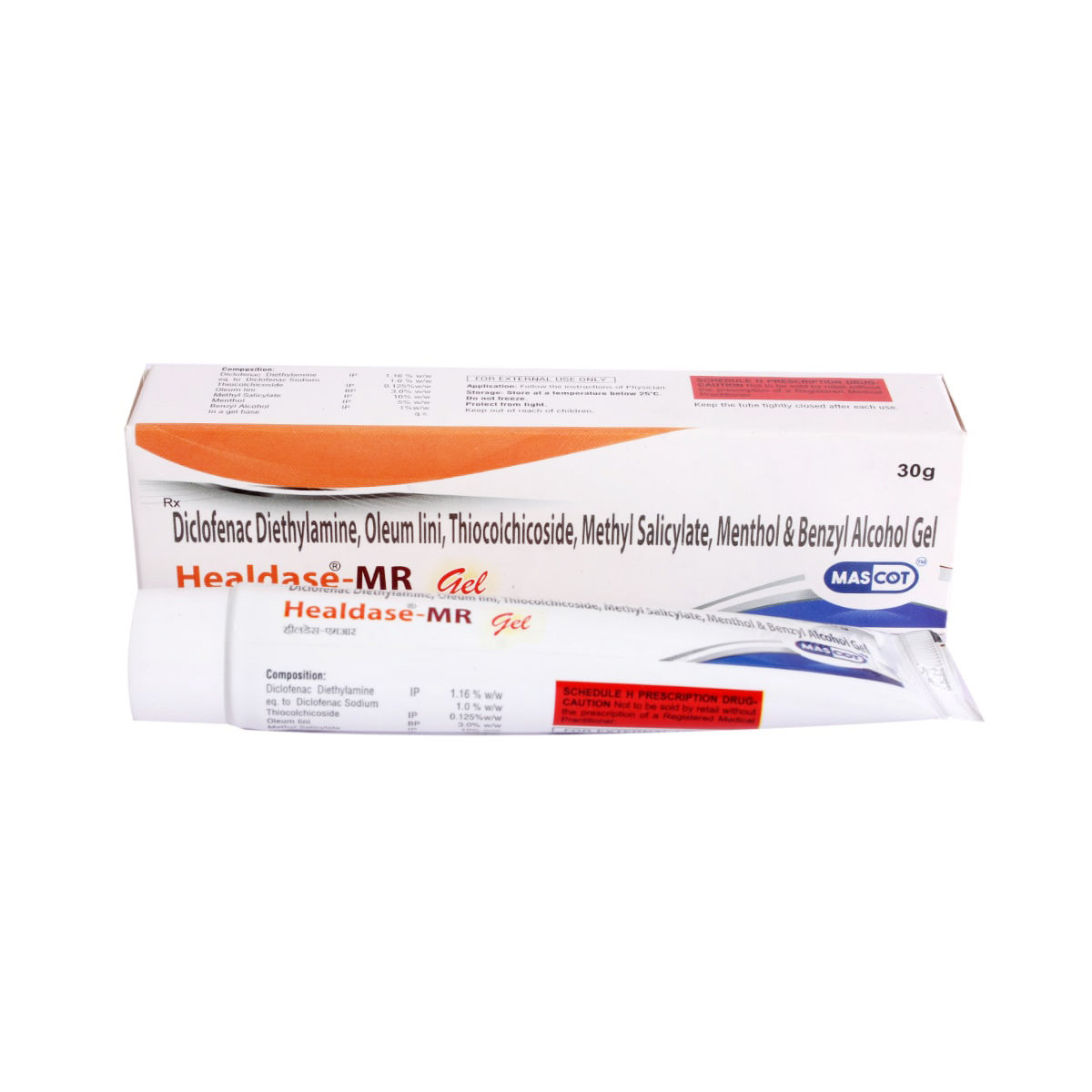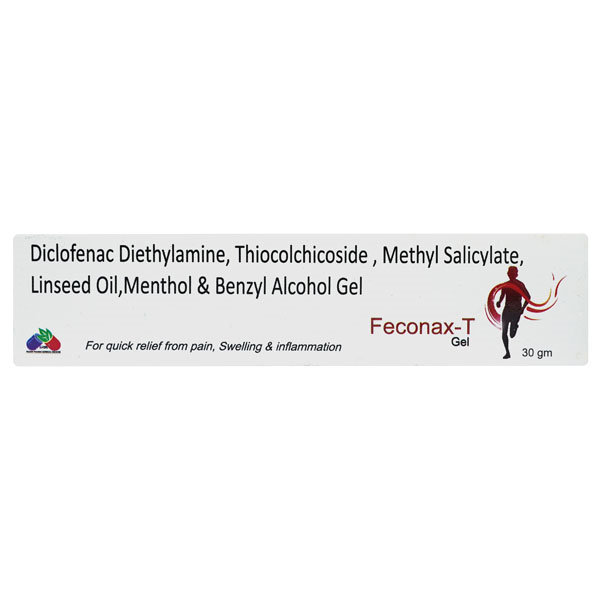- Home
- Thiocan Gel
Thiocan Gel Substitute
Thiocan Gel Substitute
Medicine Composition:
DICLOFENAC-1%W/W + LINSEED OIL-3%W/W + MENTHOL-5%W/W + METHYL SALICYLATE-10%W/W + THIOCOLCHICOSIDE-0.125%W/WAll Substitutes & Brand Comparisons
RX
Out of StockThiorok Plus Gel
Leeford Healthcare Ltd
₹25
(₹1.5/ 1gm)
71% CHEAPERRX
Thiocosteris D Gel 30 gm
Steris Healthcare
₹155
(₹5.17/ 1gm)
RX
Ortho Gold-TH Gel 30 gm
Specmed Life Sciences Pvt Ltd
₹181
(₹5.43/ 1gm)
4% COSTLIERRX
Healdase-Mr Gel 30G
Mascot Health Series Pvt Ltd
₹186.5
(₹5.6/ 1gm)
7% COSTLIERRX
Out of StockShangesic Gel
₹194.99
(₹5.85/ 1gm)
12% COSTLIERRX
Out of StockThaiclo Gel 30 gm
Stepcure Pharma Pvt Ltd
₹199
(₹5.97/ 1gm)
15% COSTLIERRX
Out of StockThioford Plus Gel
Leeford Healthcare Ltd
₹105
(₹6.3/ 1gm)
21% COSTLIERRX
Thio Viswadol Gel 30gm
Vista Cosmetics
₹210.5
(₹6.32/ 1gm)
21% COSTLIERRX
Out of StockZipflam-TH Gel 30 gm
Genesis Biotech Inc
₹190
(₹6.33/ 1gm)
21% COSTLIERRX
Rexpure Nano Gel 30 gm
Affluential Pharmaceuticals Pvt Ltd
₹215.5
(₹6.47/ 1gm)
24% COSTLIERRX
Thiobel Gel 30 gm
Blubell Pharma
₹221
(₹6.63/ 1gm)
27% COSTLIERRX
Out of StockThioford Plus Gel 15 gm
Leeford Healthcare Ltd
₹105
(₹7.0/ 1gm)
34% COSTLIERRX
Thiozed Roll On Gel 30 ml
Viswasoorya Pharmaceuticals Ltd
₹210.5
(₹7.02/ 1ml)
35% COSTLIERRX
Feconax-T Gel 30 gm
Sai Lakshmi Medical Corporation
₹243.5
(₹7.31/ 1gm)
40% COSTLIERRX
Out of StockThiopace Gel 15Gm
Usk Health Care Pvt Ltd
₹122
(₹7.32/ 1gm)
41% COSTLIER

When Should You Consider Switching from Thiocan Gel?
Patients may explore substitutes in the following scenarios:
- High monthly cost of Thiocan Gel
- Non-availability in local pharmacies
- Generic recommendation by a doctor
- Side effects or better tolerability with alternatives
What to Know Before Switching
Before you switch from Thiocan Gel to another medicine, here are some important points to keep in mind:
Same salt, different brands:
Most substitutes contain the same active ingredient - DICLOFENAC-1%W/W + LINSEED OIL-3%W/W + MENTHOL-5%W/W + METHYL SALICYLATE-10%W/W + THIOCOLCHICOSIDE-0.125%W/W, but the fillers, coating, or manufacturing quality may vary slightly.
Consult your doctor first:
Even if the salt is the same, your doctor can confirm if the substitute is right for your condition, dosage, and health history.
Watch out for allergies or reactions:
Some people may react differently to certain brands due to inactive ingredients. If you notice any side effects, inform your doctor immediately.
Price ≠ effectiveness:
A lower-priced substitute doesn't mean it's less effective. Many generic medicines work just as well as branded ones.
Check the dosage form and strength:
Always match the substitute’s strength (e.g., 5mg, 10mg) and form (tablet, capsule, syrup) with what your doctor prescribed.
Uses
Thiocan Gel is used to relieve pain and inflammation in joint and muscle conditions. The detailed uses of Thiocan Gel are as follows:
- Treats musculoskeletal pain: Thiocan Gel helps reduce pain, swelling, and muscle stiffness in conditions such as sprains, strains, and muscle injuries.
- Treats osteoarthritis: Thiocan Gel provides relief from joint pain and inflammation associated with osteoarthritis.
Medicinal Benefits
Thiocan Gel is a combination medicine containing Diclofenac, Linseed oil, Thiocolchicoside, Methyl salicylate, and Menthol. Diclofenac and Methyl salicylate work by inhibiting the effect of a cyclo-oxygenase (COX) enzyme (chemical messenger) that is responsible for pain. Thiocolchicoside exerts an analgesic and muscle relaxant effect by activating GABA inhibitory pathways. Linseed oil helps in reducing inflammation. Menthol helps provide a cooling sensation and analgesic effect. Altogether, helps in reducing pain and swelling of joints, bones, muscles, tendons and ligaments.
FAQs
The substitutes of Thiocan Gel contain the same active salt(s) - DICLOFENAC-1%W/W + LINSEED OIL-3%W/W + MENTHOL-5%W/W + METHYL SALICYLATE-10%W/W + THIOCOLCHICOSIDE-0.125%W/W. However, they may differ in price, manufacturing quality, and inactive ingredients. Speak to your doctor to find a suitable option.
Switching to a generic substitute medicine in the place of Thiocan Gel is often possible if it has the same salt, strength, and dosage form. But always check with your doctor before making any changes to your medication.
Generics versions of Thiocan Gel are typically more affordable because they don’t include the original brand's research, development, and marketing costs. They contain the same active ingredient and are approved for safety and effectiveness.
Most people don’t notice any difference. However, some may react to different fillers or coatings. If you notice any unusual symptoms after switching, consult your doctor.
Make sure the new medicine has the same active salt, strength, dosage form. Always confirm the change with your doctor or pharmacist.
Substitutes of Thiocan Gel meet the same safety and efficacy standards as Thiocan Gel, but small differences in absorption or formulation can exist. A doctor can help you choose the right one for your needs.
Yes. Substitutes of Thiocan Gel may vary in color, size, or shape due to differences in manufacturing and branding, but this does not affect how they work.
Yes, it’s generally safe to switch between multiple substitutes of Thiocan Gel if they have the same salt and strength. However, always inform your doctor so they can monitor how your body responds.
Yes, many people safely use substitutes of Thiocan Gel for long-term treatment. Just ensure it’s done under medical supervision.
If your symptoms stay under control or lab results remain stable, the substitute for Thiocan Gel is likely working well. Regular follow-ups with your doctor are important.
Absolutely. Even with the same salt, small differences can affect how your body responds when switching from Thiocan Gel to its substitute. Always consult your doctor before switching.
Thiocan Gel is used to treat Musculoskeletal pain and Osteoarthritis.
Thiocan Gel contains Diclofenac, Linseed oil, Thiocolchicoside, Methyl salicylate, and Menthol. Diclofenac and Methyl salicylate work by inhibiting the effect of a cyclo-oxygenase (COX) enzyme (chemical messenger) that is responsible for pain. Thiocolchicoside exerts an analgesic and muscle relaxant effect by activating GABA inhibitory pathways. Linseed oil helps in reducing inflammation. Menthol helps provide a cooling effect.
Avoid concomitant use of Thiocan Gel with other topical products such as cosmetics, sunscreens, lotions, moisturizers, insect-repellent creams, and other gels.
Thiocan Gel is generally safe for use on sensitive skin. However, it is always recommended to do a patch test before applying it to a larger area to check for any adverse reactions.
No, Thiocan Gel should not be applied on broken skin or wounds as it may cause irritation and delay the healing process.
You can apply Thiocan Gel up to three to four times a day, or as directed by your healthcare professional. It is important not to exceed the recommended dosage.
Thiocan Gel should not be used in children below 12 years of age unless prescribed by a doctor. It is always best to consult a healthcare professional before using any medication on children.
Buy best C.n.s Drugs products by
Intas Pharmaceuticals Ltd
Sun Pharmaceutical Industries Ltd
Torrent Pharmaceuticals Ltd
Alkem Laboratories Ltd
Alteus Biogenics Pvt Ltd
Abbott India Ltd
Cipla Ltd
Micro Labs Ltd
Lupin Ltd
Tripada Healthcare Pvt Ltd
D D Pharmaceuticals Pvt Ltd
Ipca Laboratories Ltd
Arinna Lifesciences Ltd
Icon Life Sciences
Linux Laboratories Pvt Ltd
Mankind Pharma Pvt Ltd
Cnx Health Care Pvt Ltd
East West Pharma India Pvt Ltd
La Renon Healthcare Pvt Ltd
Emcure Pharmaceuticals Ltd
Eris Life Sciences Ltd
Leeford Healthcare Ltd
Talent India Pvt Ltd
Consern Pharma Ltd
Tas Med India Pvt Ltd
Macleods Pharmaceuticals Ltd
Zydus Healthcare Ltd
Jagsam Pharma
Troikaa Pharmaceuticals Ltd
Dr Reddy's Laboratories Ltd
Ikon Pharmaceuticals Pvt Ltd
Matias Healthcare Pvt Ltd
Sigmund Promedica
Aristo Pharmaceuticals Pvt Ltd
Ardent Life Sciences Pvt Ltd
Shine Pharmaceuticals Ltd
Zydus Cadila
Theo Pharma Pvt Ltd
Wockhardt Ltd
Propel Healthcare
Lifecare Neuro Products Ltd
Crescent Formulations Pvt Ltd
Mesmer Pharmaceuticals
Matteo Health Care Pvt Ltd
Reliance Formulation Pvt Ltd
Morepen Laboratories Ltd
Ajanta Pharma Ltd
Capital Pharma
Neon Laboratories Ltd
Med Manor Organics Pvt Ltd
Akumentis Healthcare Ltd
Lyf Healthcare
Msn Laboratories Pvt Ltd
Sanix Formulation Pvt Ltd
Pulse Pharmaceuticals
Brainwave Healthcare Pvt Ltd
Hetero Healthcare Pvt Ltd
Cyrus Remedies Pvt Ltd
Sanofi India Ltd
Solvate Laboratories Pvt Ltd
Elder Pharmaceuticals Ltd
Novartis India Ltd
Psyco Remedies Ltd
Medishri Healthcare Pvt Ltd
Quince Lifesciences Pvt Ltd
Alniche Life Sciences Pvt Ltd
Crescent Therapeutics Ltd
Hbc Life Sciences Pvt Ltd
Mova Pharmaceutical Pvt Ltd
Prevego Healthcare & Research Pvt Ltd
Cadila Healthcare Ltd
Tripada Lifecare Pvt Ltd
Alembic Pharmaceuticals Ltd
Solis Pharmaceuticals
Talin Remedies Pvt Ltd
Kivi Labs Ltd
Serotonin Pharmaceuticals Llp
Glenmark Pharmaceuticals Ltd
Infivis Life Care
Aareen Healthcare Pvt Ltd
Trion Pharma India Llp
A N Pharmacia Laboratories Pvt Ltd
Gagnant Healthcare Pvt Ltd
Primus Remedies Pvt Ltd
Crescent Pharmaceuticals
Glarizonto Pharma Pvt Ltd
Knoll Healthcare Pvt Ltd
Lyceum Life Sciences Pvt Ltd
Wallace Pharmaceuticals Pvt Ltd
Zuventus Healthcare Ltd
Arches Pharmaceuticals
Cadila Pharmaceuticals Ltd
Divine Savior Pvt Ltd
Lia Life Sciences Pvt Ltd
Lincoln Pharmaceuticals Ltd
USV Pvt Ltd
Vasu Organics Pvt Ltd
Corona Remedies Pvt Ltd
Glial Life Science Llp
Maneesh Pharmaceuticals Ltd







